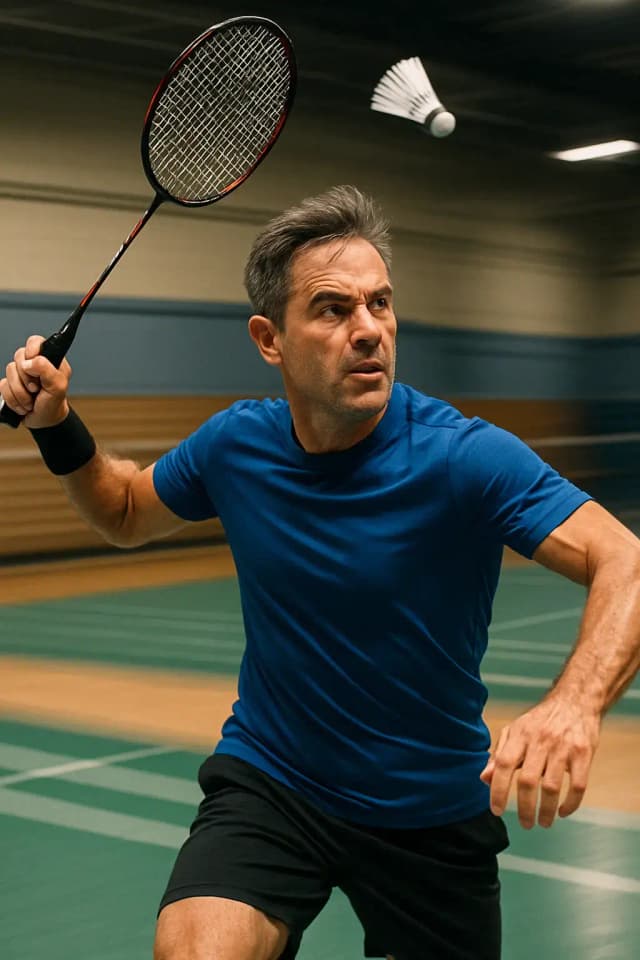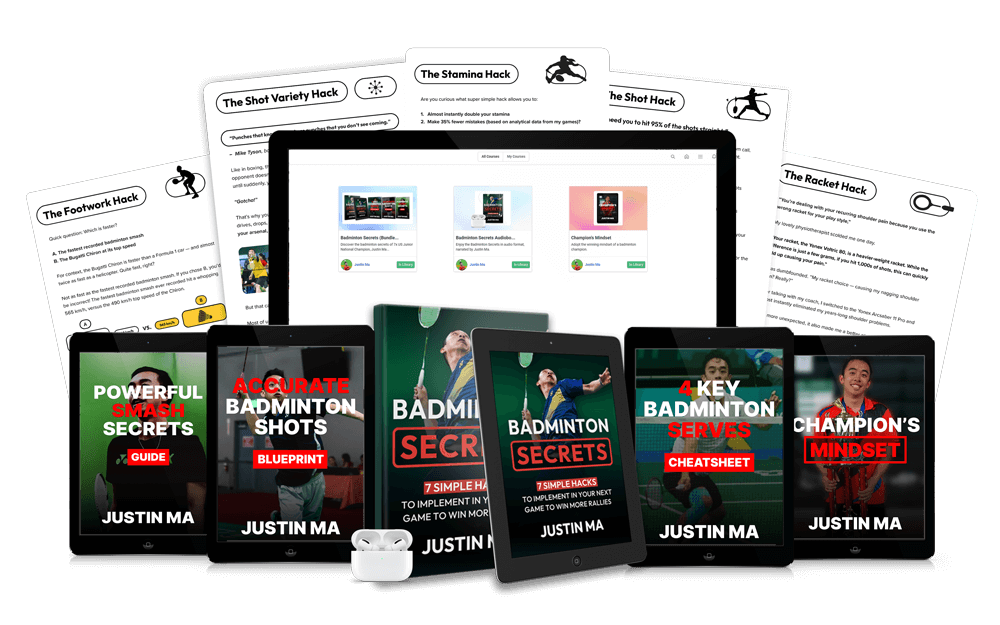By Justin Ma, 7x US Junior National Badminton Champion.
Last updated April 6, 2021
·
7 min read

Badminton clears are one of the most basic shots in the game, but one of the most important. Every player needs to know how to hit a clear. To take your game to the next level, you will need to be able to hit a variety of different types of clears and know the right time to hit them. In this post, we will be taking an in-depth look into clears. We will be talking about what clears are, how to hit a clear, the different types and varieties of clears, and how we can work on improving our clear shots.
For the sake of the simplicity of this post, we will be talking about clears in relation to singles. However, similar advice and strategies will apply to doubles players. Let’s jump right into it!
The clear is an overhead shot that is hit high and deep from your baseline to the opponent’s baseline. In the most general case, these shots are hit as a means to continue the rally. In a more high-level case (we will dive into this more after), clears are done deliberately at certain parts of the rally to either gain the offensive or to prepare for defense. The clear is one of the essential basic shots of badminton and one that beginners should learn when they just start out. At the same time, no matter what your level is, there is always room for improvement in your clears.
If you are not a beginner, feel free to skip this section! Technique is extremely important for clears. If you nail down the technique properly, you should not feel like you are wearing out your arms or shoulders even when you are hitting it full court. These are the essential steps you need to take when hitting a clear:
The first step is getting yourself in position to hit the shuttle properly. If you are able to utilize proper footwork, this should be a lot easier. If not, no worries because you can practice footwork anytime and anywhere! Make sure you are able to get behind the bird and see the shuttle above and in front of you.
After getting behind the bird, make sure to raise your arms up. Your arm holding the racket should be “behind” you and preparing to hit the shuttle, loading up a bit of energy. Your non-racket arm should also be raised up, to balance yourself and act as a counter-balance to the shot you are about to hit.
The next step is to hit the shot. At this point, you want to make sure that the point of contact is high but still in front of you. Remember that our goal is to hit to the opponent’s baseline, so you will need some height in your shot while still maintaining forward momentum. Therefore, do not hit too early (the shot will go too high) and do not hit too late (the shot will be too flat). This part takes a bit of practice to get exactly right!
After you make contact with the bird, don’t stop your swing. Make sure you follow through with the full motion of the swing. This is so you have full control of the motion and you know how to repeat it. Your swing will come more natural and you will be able to hit the shot more precisely.
These tips are all essential to make sure you are doing the clear technique properly. It is always helpful to see this done in a video as well. The video below shows a proper clear being done from multiple different angles and explains how to do so.
Clears can generally be divided into 2 main sub-categories: the defending clear and the attacking or punch clear. Let’s take a closer look at what these means and the correct situations to use them.
The defensive clear is the shot that most people are familiar with and the shot that comes to mind when people say “clear”. This is the high and deep shot from your baseline to the opponent’s baseline. The goal of the defensive clear is to get the bird as far back with good height as possible, so that the opponent does not have an easy shot to attack.
Defensive clears are good shot to help you regain control in a rally. For example, your opponent may move faster on the court or be a more “attacking” player than you – meaning they want to smash, drop, or keep the pace of the rally fast. These defensive clears are a good way to slow down the pace of the rally and get you back control.
Defensive clears are also a good option when you just want to continue the rally. You may have higher endurance and stamina than your opponent or just be more consistent and confident in your shots. You do not have to force yourself to attempt to end the rally with a smash or any other shot. Instead, sometimes it is best to hit these high and deep clears to just keep the rally going. This tests your opponent’s patience and may just lead to their own mistakes.
Finally, defensive clears can get you out of potentially dangerous situations. If your opponent continues to attack you, a good defensive clear will help reset the status of the rally and hopefully stop your opponent’s attack. By clearing it deep and long enough, your opponent will not be able to continue their full on attack and may need to change their strategy to accommodate.
Let’s take a look at the longest singles rally in the world between Tien Minh Nguyen and Jan O Jorgensen. Count how many times each player hits a high defensive clear in the same rally!
The other main variation of a clear is the attacking or punch clear. This clear is also an overhead shot from your backcourt to your opponent’s backcourt, but the height of the shot is much lower than the defensive clear and the speed is much faster. Take a look at this video to see a quick example of what this clear looks like.
As you can see, these clears have a lot lower trajectory and a lot faster pace than the normal defensive clear. These clears are a great way to add variety to your attacking shots, so that your offense is not too predictable. For example, if your opponent adjusts to the speed of your smash and drop shots, you should mix in an attacking clear to force your opponent to change their stance and move to the back during defense as well. By opening up the backcourt in your offense, your smashes will have a much higher chance to go through.
In another scenario, attacking clears can increase the tempo of the rally as a whole. You may want to do this if your opponent is a slower player than you are, or if your playing style is generally just faster. Punch clears give your opponent less time to get to the back court to retrieve the shot compared to a defensive clear.
Finally, it is just good to mix up your defensive and offensive clears. Imagine, if you hit the same shot over and over, your opponent will start to find it easy and predictable to get your shots. By mixing up different heights and speeds in your clears, your shots will be less predictable and keep your opponent’s on their toes at every minute.
Coach Andy Chong gives a good explanation in this video below on the differences between the defending and attacking clears.
There are a few things that you need to focus on when practicing clears: consistency, placement, and speed. Let’s take a look at why we need to focus on these qualities.
Consistency is the most important part of clears. This means that your clears will stay in the court and you will not make simple mistakes. This also means that the placement and height of your shot remain consistent no matter how many times in a game you hit the clear. This is extremely important because this is a shot that you will be hitting often in your games, so you need to make sure you do not give away any free points.
The next quality that you need to work on is the placement of your clears. This means, how close to the back lines you can hit them and how close to the side lines you can hit them. This also means the various heights that you hit your clears, sometimes depending on if you are hitting a defensive clear or an offensive clear. The placement of your shots makes a large difference on the quality of your clears.
Finally, you need to work on the speed of your clears. Regardless of if you are hitting a defensive or offensive clear, you need to make sure that you are hitting the clear at a relatively fast pace – attacking clears will still be faster than defensive clears though. If you hit a clear extremely slowly and very high, your opponents will have an easy time getting to the shot. Instead, when you hit it high, you should still hit it with some pace. Work on improving the speed of your clears while still keeping the bird in the court.
Finally, here are some drills that you can do to work on the quality of your clears.
This is the most basic drill and is good for warmups or beginners. With a partner, both stand at the baseline and clear to each other – just as simple as that! Work on all the mentioned qualities above and stay consistent. There should be no mistakes at all when doing this drill, so work to this level – hopefully, you get there rather quickly.
The next drill involves movement and teaches you how to get behind the shot prior to hitting clears. Start in the same position as the stationary clear drill mentioned above. After each clear, perform footwork to the front of the court and touch the front service line with your racket (net if you are higher level) before going back to the baseline and hitting another clear. Do this for as long as you can, it should get tiring pretty quickly. This drill is important for clears because even if you are out of position, you should still be able to get behind the bird and hit a good clear!
The final drill focuses solely on the placement of your clears. First, set up cones or some indicator at the baseline on the opposite of the court. Stand stationary at the back line and have a partner hit one birdie at a time to the back court. Try to aim and hit these indicators as often as you can. From this, you can start to learn the muscle memory it takes to hit these high precision clears.
Clears are one of the most basic and most important shots in badminton – make sure you master them. In your next game, try mixing up the speed and height of your clears and see how it opens up new opportunities in your game. Try both defensive and attacking clears and feel the different scenarios in which you should be using them. If you need more practice, try any of the drills mentioned above and keep practicing until you master it!
If you’d like to see more drill highlights, training highlights, or more, please check out my YouTube channel and Instagram Highlight Feed, and feel free to reach out with any questions. See you guys in the next training post!
